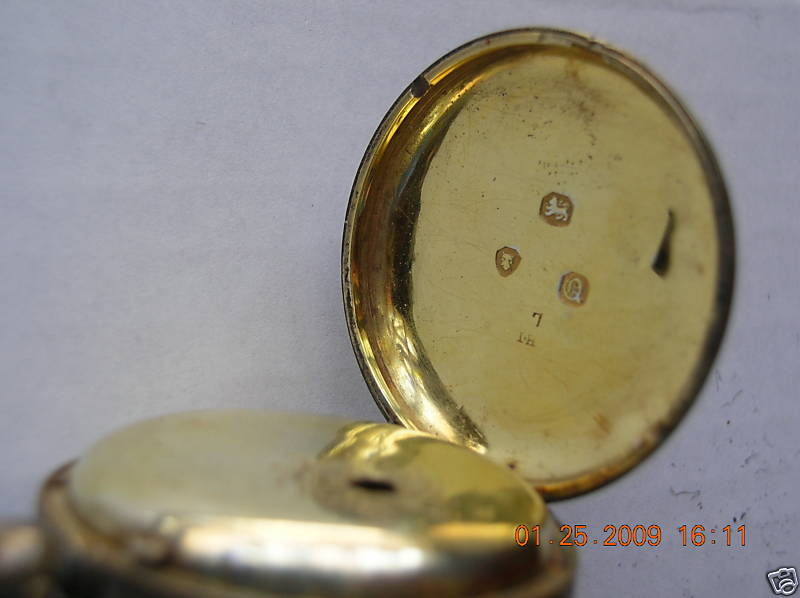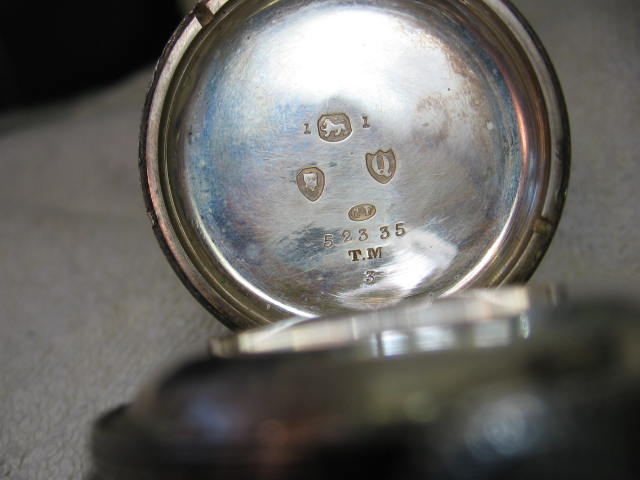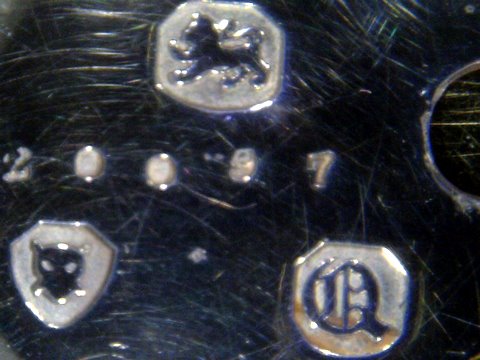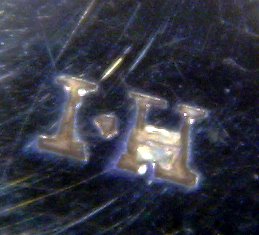
| WWT Shows | CLICK TO: Join and Support Internet Horology Club 185™ | IHC185™ Forums |

|
• Check Out Our... • • TWO Book Offer! • |
Welcome Aboard IHC185™  Internet Horology Club 185
Internet Horology Club 185  IHC185™ Discussion Site Main Page
IHC185™ Discussion Site Main Page  Horological Discussions, Questions and Answers
Horological Discussions, Questions and Answers  European Pocket Watch Forum
European Pocket Watch Forum  Question about English Hallmarks
Question about English Hallmarks
 Internet Horology Club 185
Internet Horology Club 185  IHC185™ Discussion Site Main Page
IHC185™ Discussion Site Main Page  Horological Discussions, Questions and Answers
Horological Discussions, Questions and Answers  European Pocket Watch Forum
European Pocket Watch Forum  Question about English Hallmarks
Question about English HallmarksPage 1 2
Go  | New Topic  | Find-Or-Search  | Notify  | Tools  | Reply to Post  |  |
| IHC Life Member Site Moderator |
I was wondering if anyone could tell me what the metal, date & possible maker of this case is. It appears gold but I am not familiar with the gold marks used in the UK. Thanks for any help. Tom  | ||
|
Tom, I'm not familiar with Gold cases but the date stamp and marks would suggest London 1851. The nearest casemaker using that marks would probably be Isaac Harker, (Gold Cases), 4.Prospect Row, Balls Pond Rd London. Registered the mark on 5. Dec 1845, then again in script style in 1846. The 'I.H' incursive style was later registered by John Harris in 1866. I can't see any other obvious choices. Sorry I can't offer further help, just don't know Gold marks at all. John | ||||
|
| IHC Life Member |
Tom, I agree with John in that the date stamp and marks indicate London 1851 but that top mark has me stumped....that is the mark for Sterling Silver....Recon it could be 'gold plated' siver?.... Sorry, I'm not being much help.... Regards, Jerry | |||
|
Jerry, you read my thoughts absolutely about the top marks, I wondered too if it was plated silver. I have come across this on silver cases before! I did wonder if the '7' digit showing could have been part of the '750' gold grade denoting 18Ct Gold? but it seems too defined to have a chunk missing. Tom, does the inner cuve have any other marks on it to suggest it's plated rather than precious metal? | ||||
|
| IHC Life Member Site Moderator |
Thanks Jerry & John, I too don't know gold marks, I agree that it does look like the sterling mark so I am not sure. I went a head & bought it so when I get it & can take a better look I will post more photos. Tom | |||
|
Tom, I've just magnified the image, and it may be a tarnished Silver case rather than Gold. The colour isn't uniform and quite white in places, especially over the crowns of the hallmarks and in the curve of the dome near the hinge. I'm going to stick my neck out and say it's Sterling Silver. Hope you didn't pay Gold prices for it if it is Silver ........ John | ||||
|
| IHC Life Member Site Moderator |
Hi John Hopefully I paid for sterling, it has a movement in it too but I don't know what it is yet either, I think it will be a fusse. I tend to buy things that are unclear what they are, usually I do alright. I will let you know what it turns out to be. It may be silver after all. Thanks again. Tom | |||
|
Tom, I thought I was the only one who bought fuzzy pictures and descriptions, I hit allright in the better part of the purchases, but there are always some I regret. Bill | ||||
|
Tom, it's certainly silver, 925/1000, striken in London, 1851, as John says. The maker could, I think, also be John Horsley if the dot in between is a star, or absolutely John Harris if a round dot. To be gold there should have been a crown (like sheffield) instead of the lion passant plus either "22" or "18". In any case, silver has a specific weight little higher than half of gold (10 to 19, roughly), and this could be the final proof. | ||||
|
| IHC Life Member Site Moderator |
Thank you everyone for your replies, I will post some better photos after I get the watch, I thought there were different marks for gold, perhaps it is just very tarnished & I know I have seen other photos of watches that look gold but are described as silver. Bill, most of my buys are with fuzzy pictures, I have done alright on most of them but a few I regretted. My best one was $3.00 total that I resold for $723.00 so I guess I can't complain too loud. Thanks again all. Tom | |||
|
Sorry Tom, I made a typo on the casemaker I posted, it's John Hasker, I wrote Harker. I'm still sticking with this guy though, because although as Mario suggests, 'John Harris' also registered the mark, there were a few of them, one of whom was registered in Coventry - but in 1866 & too late for your watch. All the other 'John Harris' (I.H Incursive) marks I could find were either much too early for this date mark (by some decades), and the rest used a shield - John Hasker didn't, his mark is the incursive style (No shield) and registered within the right time frame. Have to agree about the fuzzy photo's Too, some of the best buys I've ever made have had lousy pic's and an 'Old Pocket Watch for Repair' listing header. Trouble is now, eBay's getting so flooded with the things, I just about give up the will to live trawling through them all. John | ||||
|
| IHC Life Member |
Not to worry Tom....even if it is Sterling, I sometimes prefer Sterling over gold....one doesn't have the brasing worry with sterling.... Unless it's solid gold then that IS different.... Regards, Jerry | |||
|
John, I definitely buy your opinion. In any case I'm pretty sure it is silver. Personally I stay as far from solid gold cases as possible: I think that they always overcharge the price because of the magic words, solid gold, and nobody, as far as I have seen, gives the CASE net weight ... Silver cases are a different story, expecially English, there nine times out of ten everything is clear. | ||||
|
| IHC Life Member |
Hey Tom, check this one out....It is a Sterling Silver case that I have and it has the same hallmarks that yours has.... Regards, Jerry  | |||
|
| IHC Life Member Site Moderator |
Yep, sterling & London just a different year. I think everyone is right & it will turn out to be a sterling case, which is fine I still got a good buy on it, would of been even better if gold. Thanks everyone for your help, when I get the watch I will post some better photos. Tom | |||
|
| IHC Life Member Site Moderator |
Well the watch came today & I don't know what to make of the case, it is gold colored & if it is plated there is not any wear at all. It is approx a US Size 10 movement & fusse driven, I will give it a shot this weekend. The case empty weighes .940 troy oz. Below are some over-all photos of the case & then a couple of the hallmarks. The closeups of the hallmarks it is hard to make out the color since I am so close. Any ideas? Did the English make gold plate cases? Like I said there is no brassing or anything like what you see on US cases. Tom  | |||
|
| IHC Life Member Site Moderator |
Case marks  | |||
|
| IHC Life Member Site Moderator |
Any new ideas on the maker?  | |||
|
| IHC Life Member Site Moderator |
John I missed you comment about the number 7 eariler. It does have the number 7 but is clearly marked & no other numbers with it, however above the hallmarks it does have the serial number of the case which matches the serial number of the movement so it does have an extra 7 for some reason on both lids. Also where you corrected the spelling on the case makers name you changed his 1st name from Issac to John, wish one is correct. Thanks for everyones input. Tom | |||
|
Tom, it's definitly a silver hallmarking, no way: lion passant= 925/1000 grade silver, leopard head without crown= London, gotic Q= 1851. As far as the maker, I think that's John Hawkins because of the shape of the dot between I and H. BUT ... it's really heavy, too heavy to be silver, 29.14 gr., whereas an heavy silver one of that size would be around 20-22. I have seen, and I have Victorian silvers gilt, but they are matte, never plated or rolled. If it was mine, I would either try to determine volume, and thus specific weight or take it to a jewelier. What puzzles me is that the hallmarks are so clear that there is no possible mistake there. However at that time in UK gold could be hallmarked as such ONLY if it was full 22k or 18k, so if I.H wanted a really gold colored item, shining, may be has deep plated it, and hallmarked as silver: laws were and are rather harsh for forging precious metals in UK. Interesting piece, in any case. | ||||
|
Apologies Tom, need to get some sleep I think It should be Isaac Harker - but for Gold Cases only, as that's a specific entry for this maker. Mario, I've checked all through my reference, and the only John Hawkins I can find was in 1733, and although he used 'IH', there's no dot between the letters in my book. Which publication do you use for ID's on makers? I did turn up another very likely candidate, and that's John William Hammon. Although he first registered the mark I.H in 1822, he used it continuously up to around 1873 either incursive, with a shield, IH without the dot, or the I.H similar to Tom's case. He did however use a mark as I.H incursive, registered 5th Feb 1849 and appears to have been used until 1854, when he changed to IH (no dot) in a shield. His address at that time was 11 Sekforde St, Clerkenwell (also address of manufactuary - sic), where he operated for quite some time - from 1844 - 1873. He used IH without the dot continuously from then on. I'd suggest pulling the movement from the case, and scraping some material from inside the band, you should be able to tell what's under the skin from that. Cases were Gold plated, and I have a Swiss fob watch here that's silver with a distinct Gold tint, not sure when or where this was done though. If it is heavy Gold plate, I'd say it would have been done to order by the owner to dress it up as something better than silver. John | ||||
|
John, thanks a lot. I use basically two sites, www.silvermakersmarks.co.uk/ and www.ascasonline.org/ plus searching on specific issues: besides PWs I collect also UK silver, mainly of Victorian era (Georgians are much closer to my tastes but ... not to my pocket), and in general I have had good response from the comparison of both sites & www searching & the pieces themselves. as I wrote to Tom, my idea is that I.H wanted true shining gold color, but not the solid gold cost, and wanted to stay away from a long spell in jail too, so he used a core of silver, deep plated it, but not reaching the 18k mark, hallmarked for silver. Legally I think he was safe and sound, in this way. I would greatly appreciate your frank comments. Thanks as ever for your time. | ||||
|
| Powered by Social Strata | Page 1 2 |
| Your request is being processed... |
|
©2002-2025 Internet Horology Club 185™ - Lindell V. Riddle President - All Rights Reserved Worldwide

